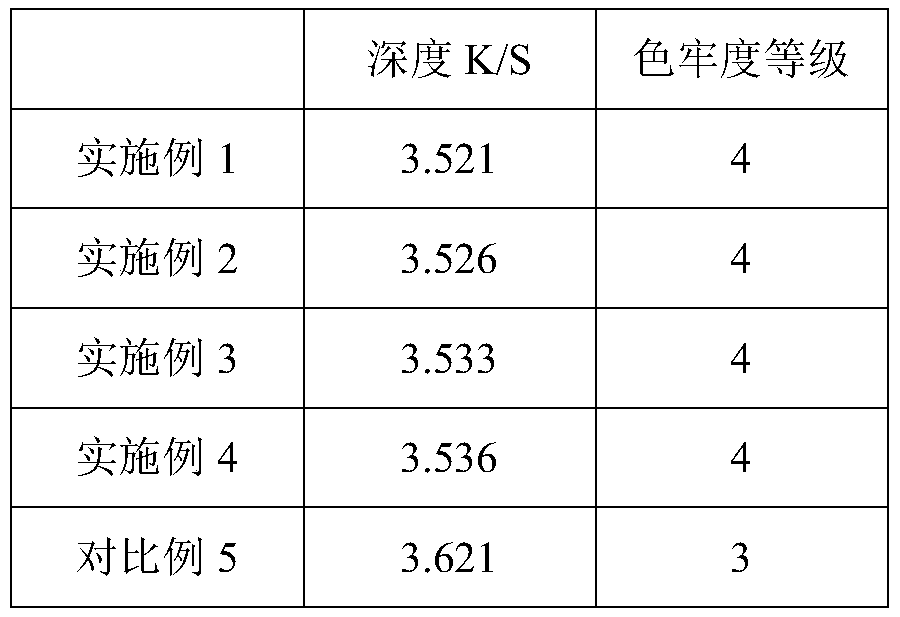High-safety non-yellowing viscoelastic softening finishing agent and preparation method thereof
A softening agent and solvent technology, which is applied in the field of high-safety non-yellowing slippery elastic softening agent and its preparation, can solve the problems of easy yellowing of products, achieve uniform emulsification, good dispersion, and avoid agglomeration
- Summary
- Abstract
- Description
- Claims
- Application Information
AI Technical Summary
Problems solved by technology
Method used
Image
Examples
Embodiment 1
[0049] A softening agent, comprising the following components by weight: 15 parts of amino silicone oil (ammonia value 0.4), 8 parts of polyvinyl alcohol, 1 part of hydroxymethyl cellulose, 1 part of nano-titanium oxide, 5 parts of EL-20, 1 part of acetic acid, 1 part of aloe extract, 3 parts of absolute ethanol, and 10 parts of water.
[0050] The preparation method of the aloe extract comprises the following steps: drying and pulverizing the aloe, adding 5 times the amount of 75% ethanol, ultrasonically extracting for 1 hour, with an ultrasonic power of 100w, and filtering, the filtrate is sequentially extracted with ethyl acetate and petroleum ether, and the petroleum ether The extract is concentrated, dried, and obtained.
[0051] The preparation method of softening agent comprises the steps:
[0052] (1) Mix amino silicone oil, 50% EL-20, acetic acid, nano-titanium oxide, and absolute ethanol, and sonicate at 35°C for 1 hour to obtain solution 1;
[0053] (2) Add polyvi...
Embodiment 2
[0056] A soft finishing agent, comprising the following components by weight: 15 parts of amino silicone oil (ammonia value 0.4), 8 parts of polyvinyl alcohol, 1 part of hydroxymethyl cellulose, 1 part of antibacterial agent, 5 parts of emulsifier, 1 part of acetic acid 1 part, 1 part of aloe extract, 3 parts of absolute ethanol, 10 parts of water.
[0057] The antibacterial agent is a mixture of nano-silver, nano-titanium oxide, and zinc oxide, and the mass ratio of the three is 1:4:1;
[0058] The emulsifier is a mixed emulsifier composed of EL-20, EL-40, PEG-200 and PEG-400, and the mass ratio of the four is 1:1:2:3.
[0059] The preparation method of the aloe extract comprises the following steps: drying and pulverizing the aloe, adding 5 times the amount of 75% ethanol, ultrasonically extracting for 1 hour, with an ultrasonic power of 100w, and filtering, the filtrate is sequentially extracted with ethyl acetate and petroleum ether, and the petroleum ether The extract is...
Embodiment 3
[0065] A softening finishing agent, comprising the following components by weight: 25 parts of terpolymeric silicone oil (copolymer of tetramethyldihydrogen disiloxane, amino polyether compound, allyl epoxy vinyl ether), poly Vinyl alcohol 12 parts, hydroxymethyl cellulose 2 parts, antibacterial agent 3 parts, emulsifier 10 parts, citric acid 2 parts, aloe extract 2 parts, isopropanol 8 parts, water 15 parts.
[0066] The antibacterial agent is a mixture of nano-silver, nano-titanium oxide, and zinc oxide, and the mass ratio of the three is 3:8:1;
[0067] The emulsifier is a mixed emulsifier composed of EL-20, EL-40, PEG-200 and PEG-400, and the mass ratio of the four is 1:3:4:6.
[0068] The preparation method of the aloe extract comprises the following steps: drying and pulverizing the aloe, adding 8 times the amount of 95% ethanol, ultrasonically extracting for 2 hours, with an ultrasonic power of 300w, and filtering, and the filtrate is sequentially extracted with ethyl a...
PUM
 Login to View More
Login to View More Abstract
Description
Claims
Application Information
 Login to View More
Login to View More - R&D
- Intellectual Property
- Life Sciences
- Materials
- Tech Scout
- Unparalleled Data Quality
- Higher Quality Content
- 60% Fewer Hallucinations
Browse by: Latest US Patents, China's latest patents, Technical Efficacy Thesaurus, Application Domain, Technology Topic, Popular Technical Reports.
© 2025 PatSnap. All rights reserved.Legal|Privacy policy|Modern Slavery Act Transparency Statement|Sitemap|About US| Contact US: help@patsnap.com



